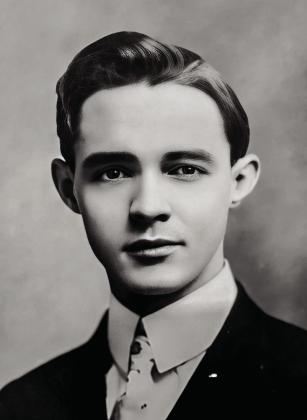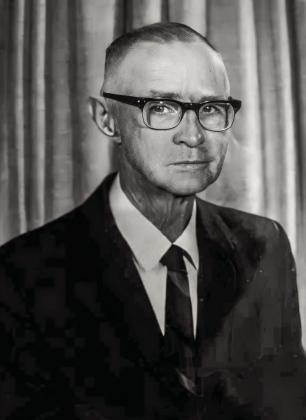In 1950, Dora Tubbs, the long-time owner of Pettijohn Springs, sold the park to Lynn Gruwell and Mable Ruth Stong, two businesswomen from Ardmore. Lynn and Mable had big plans for reopening the park, but their plans “pooped out,” and they never upgraded or reopened the park, then came to their “Wits-End” and listed the park for sale. After a few months on the market, the park was sold to a local Madill Businessman, Edgar Earl Ayres in 1954.
EdgarEarlAyreswasborn on May 20, 1888, in Denison, Texas, to William Alexander Ayres and Rosa Belle Allred Ayres. Edgar Earl would eventually be known as Earl Ayres.
Earl was one of ten children of William Alexander Ayres. William was born in Carroll County, Georgia, in 1850. He first married Adelia Ingram, who was also of Carroll County, Georgia. Shortly after their marriage, William and Adelia moved to Grayson County, Texas. After moving to Texas, they had four children. Sadly, Adelia passed away in 1879.
OnJune13,1880,William married Rosa Belle Allred of Denison, Texas. William and Rosa had six children. Earl was their fourth child. While livinginTexas,Williammade a living as a stock dealer, buying and selling cattle, horses and other livestock.
Around 1902, the Ayres family moved to Woodville, Indian Territory. There, William purchased some farmland with money he had saved while working as a livestock dealer and began to operate a farm. The children were then all enrolled in the Woodville school.
After graduating from Woodville school around 1906 or 1907, Earl moved back to Texas, where he met and married Sylvia Gertrude Baker on May 10, 1908. Sylvia was originally from Bentonville, Arkansas. Earl and Sylvia then settled in Grayson County, where they lived until about 1911, when they moved to Woodville, Oklahoma. While living in Grayson County, Earl was employed in the dry goods business as a salesclerk and merchandise buyer.
Earl and Sylvia lived in Woodville from 1912 until about1917,whentheymoved to Madill. Earl and Sylvia had eight children in their marriage. The first two were born in Grayson County, the second two were born in Woodville, and the last four were born in Madill.
When Earl and Sylvia moved to Woodville, Earl became the manager of the Henry-Coffee Co. dry goods store, which was owned by Samuel Wright Henry and Tom Christian. In the September 25, 1913, edition of the Madill Times, it was reported that Earl “had a number of years experience as a sales clerk, and he is a good one and is proving to be as good a buyer as he is a seller.”
In January 1917, Earl was appointed as the Deputy County Clerk for Marshall County by the newly elected County Clerk, Guy Douglas. Guy Douglas had been the owner and operator of the “Best Drugs” store in Woodville for many years. It was after he was appointed Deputy County Clerk that Earl and Sylvia moved to Madill. As Deputy County Clerk, Earl was paid $75 per month.
EarlandSylviawerefaithful members of the Church of Christ. Upon moving to Madill, they placed membership at the Madill Church of Christ, and within months, Earl was appointed to serve as an Elder of the church. It was a position he held for fifty-one years.
In August 1917, County Clerk Guy Douglas accepted a commission in the United States Army. He was sent to an officers’ training camp at Leon Springs, Texas, and resigned as County Clerk. He would then serve almost two years in the army during WWI.
Upon Douglas’s resignation, the County Commissioners for Marshall County appointed Earl to the office of County Clerk to serve until the next election. At that time, elected county officers servedtwo-yearterms. Inthe September 13, 1917, edition of the Madill Record, the editor of the paper wrote: “The Record does not hesitate to say that there could not have beenamoreappropriateman in the county in which to trust this very important office than Mr. Ayers and feel sure that the business of the office will at all times be attended to in a credible manner.” Upon his appointment to the office of County Clerk, Earl’s salary increased to $120 per month.
In March of 1918, Earl announced his candidacy for election to the office of County Clerk. In announcing his candidacy, the Madill Record stated that Earl is “well acquainted with the duties of said office. The office of County Clerk is one of the mostimportantinthecounty, and a reliable, honest business man should be placed in that office. Mr. Ayres will fill that bill, and if elected to the office, will no doubt give entire satisfaction.”
Roy Stone, the then Deputy Court Clerk for Marshall County, was also running for the office of County Clerk. During the campaign, the Madill Record and the Kingston Messenger newspapers both endorsed Earl for election to the office. Earl was then elected to the office. In 1920, Earl again ran for re-election and due to his popularity and strong record, he ran unopposed. He was elected by acclamation.
After serving fifteen months of Guy Douglas’s term and two full terms, Earl ran for Marshall County Treasurer in 1922. Earl’s opponent was Edward Sacre. Unfortunately, Earl was defeated by only 39 votes.
When Earl’s term ended in January 1923, he accepted thepositionofDeputyCounty Clerk under the direction of newCountyClerkJ.M.Scott. However, in May 1923, Earl resigned as Deputy County Clerk and went into private business.
In 1923, Earl partnered with R. E. Dawson to open the firm of Ayres and Dawson. The firm was a general real estate, insurance and farm loan business in Madill. Their officers were upstairs in the Madill National Bank building. Then, in 1926, Earl accepted the position of Madill City Treasurer. Earl held this position for over ten years, resigning in May of 1937.
Over the next thirty years, Earl was very active in his real estate business, and because of this, he acquired several prime pieces of property in the county, including Pettijohn Springs. However, Earlneverreopenedthepark. Bythetimehehadpurchased it, the pool was in disrepair, the grounds were overgrown and he was not interested in operating an amusement park.
In1965,theMadillChurch of Christ hired a new young minister named William Jefferson Davis “J.D.” Walker. Because of Earl Ayres and J.D. Walker, the story of PettijohnSpringAmusement Parktookaturnthatchanged not only the park's future but also the future of the lives of thousands of young people.
Edgar Earl Ayres passed from this life on March 18, 1968. By the time Earl Ayres passed, the park had been closed for eighteen years. But a new day was coming.
More on that in Part XV.
If I may add a personal note. As many of you know, multiple generations of my family were born and raised in Marshall County.
My ancestors came to what is now Marshall County around 1890. Several members of my family still live in the county today.
During my research for this part of the story of Pettijohn Springs, I learned something I did not know. As it turns out, my third greatgrandmother, Eliza Isabella Goff Cross, was Earl Ayres’s grandmother.
My third great-grandmother, Eliza, was first married to James Cross and their oldest child, Ann Jane, married my great-great-grandfather, Perry Center Henry. Following the death of her husband, James Cross, Eliza married William Allred.
Their first child was Rosa Bella Allred, Earl’s mother. Therefore, Earl Ayres is my first cousin, three times removed. So, I am kin to the entire Ayres family.
I never knew we were related. I look forward to meeting my family soon. One more historical point, Earl’s and my first cousin, James Burr V. Allred, was the 33rd GovernoroftheStateofTexas. It truly is a small world.


